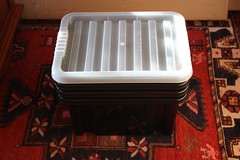I’ve been using a ‘traditional’ technique for ensuring my bees have enough ‘backup’ stores over winter, using nothing more than 1kg sugar bags. I first heard of this technique while perusing an article on overwintering bees from the Dunfermline and West Fife Beekeeper’s Association, and through a bit of trial and error have come up with my own two methods of using it.
Winter Method
Take a 1kg paper-wrapped sugar bag and immerse the entire bag in a bucket of water for around 20-30 seconds, turning and squeezing gently to allow any trapped air to escape and for water to enter the bag. Lift the bag out very carefully (the wet paper can tear easily) and place somewhere undisturbed in the warm to dry (on top of a radiator or on a rack in an airing cupboard is best). The bags will dry out and form a hard crust like a giant sugar cube in a day or two.
To use, simply cut a few holes in one side of the bag, with a knife or hive tool, big enough to allow the bees access (but not so big that the sugar can fall through onto the colony) and place directly onto the frames, surrounded by an eke or empty super to lift the cover board and roof. (Optionally with some insulation put into the empty space to prevent heat loss.
Early Spring Method
As above, but instead of leaving the bag to dry out, instead drip-dry and place directly onto the cover board for the bees to feed on. The wetness means this is half way towards a spring syrup feed, which will encourage the bees.
(This method can be used in the middle of winter too, but care must be taken that the water in the bags doesn’t cause cold and damp problems for the bees).
In both cases I put 2, 1kg bags into each hive, as this allows you to cover all the frames with some of the bag, meaning the bees can always use it as a bridge, preventing isolation starvation.
Any sugar left in the bags after winter can be taken and used to make syrup for spring feeding.
Read more...

